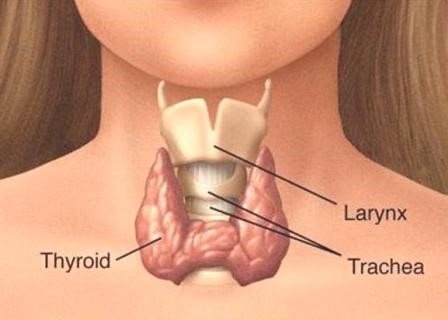
Hypothyroidism is one of the most common hormone conditions. Estimates have 10-12% of the US population being affected by a thyroid problem during their lifespan and women are more often affected than men. People with diabetes, high blood pressure, high cholesterol and osteoporosis have a higher risk of also having hypothyroidism.
Where is the thyroid gland and what does it do?
The thyroid gland sits in the middle of the lower neck and has two lobes and a bridge between the lobes. When enlarged it is often referred to as a goiter.
The thyroid cells manufacture and release thyroid hormones mostly T4 and some T3 into the bloodstream. The hormones are essential to regulating normal metabolism or the way the body uses energy from the consumption of food and caloric beverages. Since T3 is more active than T4 and is required for proper metabolism, most of the T4 is converted to T3 before being used by the body.
How does the thyroid know to release thyroid hormone?
The release of the T3 and T4 is regulated by the pituitary gland in your brain. This small gland releases thyroid stimulating hormone (TSH) when it senses the body needs more hormone to meet its metabolic needs. The TSH messages the thyroid gland to make and release T4 and T3.
What is hypothyroidism?
Hypothyroidism refers to an underactive gland and is much more common than hyperthyroidism, an overactive gland. Most cases of hypothyroidism are due to an immune system dysfunction causing it to attack and digest the thyroid gland’s hormone secreting cells. This eventually leaves it incapable of manufacturing enough thyroid hormone to meet the body’s needs. Secondary causes of hypothyroidism can occur with dysregulation from an abnormal pituitary, after surgical removal of the thyroid or post radiation treatment for an overactive thyroid. Although some thyroid conditions are temporary most hypothyroid conditions are permanent conditions.
What are the symptoms of having too little or too much thyroid hormone?
I like to think of having too much thyroid hormone as being Speedy Gonzales and too little as being like Speedy’s cousin Slowpoke Lopez who is the “slowest mouse in all of Mexico”.
Speedy has too much thyroid hormone and rarely stays still. He has a fast heartbeat, GI runs (diarrhea), doesn’t sleep, loses weight easy despite a large appetite and seems anxious. Speedy sweats and feels hot when others are cold.
Slowpoke having too little thyroid hormone is tired all the time. He has a slow heartbeat, constipation, sleeps a lot, has a hard time losing weight and seems depressed in a mental fog. He feels cold when others are hot.
The most common symptoms of hypothyroidism are fatigue and cold intolerance.
How is hypothyroidism treated?
Fortunately, most cases are easily treated with long term thyroid hormone replacement therapy. A once a day supplement of T4 (thyroxine) taken orally is the recommended treatment. The T4 is converted by the body tissues to T3 as needed. T4 is used because it has a longer half-life (about a week vs less than a day for T3) and has a more consistent therapeutic range. A few people (5-10%) cannot convert T4 to T3 normally and they would benefit from supplementation of with T3 (triiodothyronine) instead.
How is hypothyroidism diagnosed and monitored?
Since the brain is smart and knows how much your body needs doctors mostly just need to measure the TSH to diagnose and monitor the effectiveness of replacement therapy. If the TSH is normal the patient is on adequate therapy or has normal thyroid function. If the TSH is high, the pituitary is calling for more thyroid hormone and they have hypothyroidism or if on replacement the dose needs adjusted up. If the TSH is too low there is a hyperthyroid state and the dose needs adjusted down. In some people with dysfunctional TSH signals from an abnormal pituitary and those that don’t convert T4 normally then measures of T4 and T3 are needed to monitor replacement therapy.
Most patients usually feel better with a TSH at or below 2.5 mU/L wanting to feel more like Speedy than Slowpoke.
Sources:
- [i] DAVID Y. GAITONDE, MD; KEVIN D. ROWLEY, DO; and LORI B. SWEENEY, MD, Dwight D. Eisenhower Army Medical Center, Fort Gordon, Georgia. Am Fam Physician. 2012 Aug 1;86(3):244-251.




